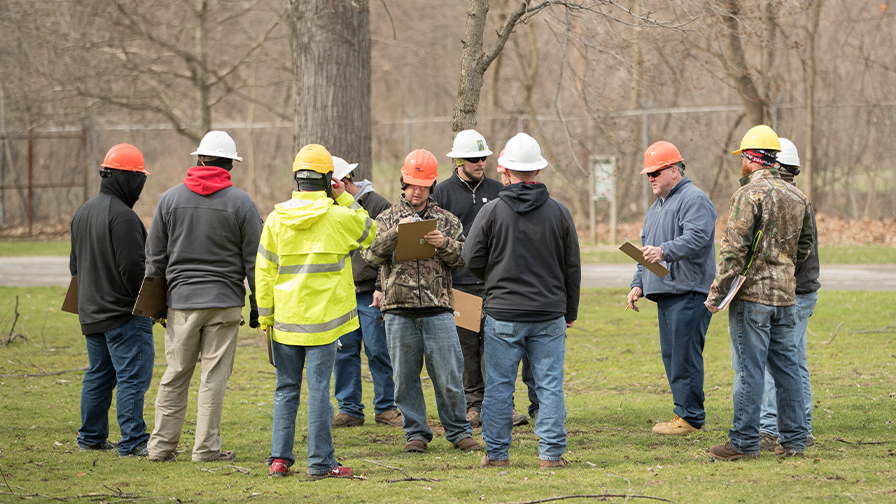- Vegetation Management Services
- In Your Neighborhood
- About
- Careers
- Webinars
- Articles
Using Safety Audits to Reduce Risks and Improve Crew Safety

Using Safety Audits to Reduce Risks and Improve Crew Safety
By Bob Urban, senior manager, ACRT Services
When it comes to safely performing tree work of any kind, best practices are essential. Keeping people safe on the job is a top priority — whether you’re a utility or a company that provides services to utilities. The daily and long-term benefits of using a safety monitoring program will not only improve the lives of the worker on the truck but also the stress and cost for management and ownership of organizations. From improving worker career longevity to stabilizing or reducing worker compensation insurance premiums — safety programs pay.
Too often, taking a closer look at how a given crew works and operates according to safety best practices and procedures is prompted by an accidental injury or even death. Beyond the human cost, the tree crew and the organization that has contracted them for work are both suddenly under significant pressure. Accidents may result in Occupational Safety and Health Administration (OSHA) penalties, higher insurance rates, workers’ compensation claims, and potential loss of long-term contracts when the clients have safety as a performance metric.
Adherence to safety best practices is a critical part of any type of work and doing everything possible to ensure that crews are upholding their commitment to safety is paramount. So how do you ensure safety best practices are always being followed? A comprehensive series of safety audits and feedback reporting or on-site, real-time training conducted by a third-party partner might be the answer.
A comprehensive safety audit program can be invaluable for any tree care organization, even when it might appear that your crew is adhering to safety practices. These audits will provide a detailed, objective assessment of a crew or contractor’s safety practices.
Safety audits of your crew should be performed at random and be unanticipated to get a real sense of how your crew is performing.
Every organization should consider implementing the following 10 audit areas as they are critical for overall crew safety and business success.
- Pre-job briefing. Each project should begin with a pre-job briefing that coordinates the activities of each member of the crew. Auditors ensure the entire crew is involved in a job briefing before starting the job. They also ensure the job briefing has information about job hazards, including work procedures, special precautions, and appropriate personal protective equipment (PPE).
- Aerial lift operation. Aerial lift trucks are an essential tool for the work your crews perform, and the safe operation of this kind of heavy machinery is critical. According to OSHA, major injuries and fatalities associated with aerial lifts include falls and electrocutions. Your audit team will check to ensure tree crews are wearing and utilizing the right body harnesses, including an attached lanyard to the boom or basket. They’ll also check to see that lift platforms are positioned at a safe distance from electrical lines and that the correct brakes or wheel chocks are being used when the lift is parked and positioned. More focused audits can include a pre-job inspection that consists of flying the boom to ensure the equipment is free of mechanical issues, reviewing maintenance records, and inspecting equipment for general wear and tear.
- Traffic control. Tree work will often bring crews near roadways, so it’s important to make sure that crews are working safely in and around traffic flows. For this safety audit, an auditor will look to see that crews are taking the proper precautions, using traffic cones as necessary, following local Department of Transportation specifications, and ensuring that traffic has not been obstructed in an unsafe way.
- Tree felling. There are a lot of activities involved in auditing tree felling. This audit will primarily focus on workers performing tree felling from the ground. Audit teams will look for technical safety, such as proper notching and rigging techniques, but also softer safety skills such as proper communication skills across the entire crew as a tree are being removed.
- Crane operation. Cranes are a major piece of machinery that can cause significant damage or injury if deployed improperly. Often used to remove large branches, or sometimes entire trees, auditors look for multiple items when auditing safe crane-operating practices. Are crews keeping cranes clear of electrical hazards? Are they ensuring cranes haven’t been overloaded? Are materials properly secured? Is the crane operator following and performing all the right functions within the manufacturer’s tolerances?
- Climbing safety. Tree climbing is a risky part of an arborist’s job and close adherence to safety practices is imperative. Audit teams should check to ensure that all the proper techniques are being followed and that all the necessary equipment is inspected before use, including harnesses, carabiners, ropes, and personal protective equipment. It’s also important to ensure equipment is being used for the purpose it was designed for and kept in manufacturers’ rated tolerances.
- Chain saw safety. Safe chain saw operation requires constant, continual attention to all safety measures, but it’s not uncommon for even veterans to become complacent and develop poor habits. Auditors will check for proper handling and cutting techniques, following the American National Standard for Arboricultural Operations – Safety Requirements (ANSI Z133). The size of the saw for the task being performed should also be noted.
- Wood chipper operation. Wood chippers are another essential tool that have the potential to be extremely hazardous. Your audit team must evaluate how tree crews handle and work around the equipment. Auditors will ensure that tree crews are properly maintaining the equipment for safe operation, in addition to the proper use and towing connections for the machine.
- Equipment use and technology solutions. Technology and improved techniques for performing all aspects of the job is likely under-recognized. Using the right gear for the job when approaching difficult or technical situations can reduce the potential for an accident. Using a qualified auditor to provide that feedback and training to workers in real-time, on the job will improve productivity and worker confidence as well as potentially worker longevity.
- General housekeeping. Keeping things neat and organized is critical to safety, and that means making sure that generalized housekeeping among tree crews is orderly, and accounts for all the essential items. Auditors should check to make sure that crews have the necessary cones for traffic work, a full stock of water to ensure crews remain hydrated, first aid kits, and fire extinguishers are present in the event of an emergency, and ensure that things are labeled properly and stored safely. Equipment that is stored in the proper compartments and cab cleanliness are also points not to be overlooked.
Choosing an audit partner
When you’re looking for a third-party partner to perform a safety audit, what criteria should you consider? Make sure that your audit team is well-versed in the appropriate OSHA- and industry-specific standards. For example, utility vegetation work is governed by the OSHA Code of Federal Regulations (CFR) 29 1910.269 and ANSI Z133. An audit partner that is involved with relevant committees will have vast knowledge and understanding of the safety standards to which your crew must adhere. In addition, the more industry experience an auditor has, the more likely they are to have great familiarity with safety best practices. With the right experience and knowledge, your audit partner will be able to work with you to develop a comprehensive auditing program that evaluates in real-time how your crew is working in the field. Not all crews necessitate the same level of auditing. When selecting a partner to conduct your safety auditing, you should first identify the skills and background for the level of detail desired.
Benefits of an auditing program
Qualified vegetation management workers may go through formal safety training once a year where they’ll learn about aerial rescue, chainsaw use, tree felling, wood chipper safety, rope and saddle climbing, bucket operations, and more. However, safety is more than a once-a-year event, and perhaps more important than anything is consistency in working safely and following best practices. It’s one thing to pass an annual safety test, but it’s another to work the same way many months later when no one is evaluating you.
Auditing programs traditionally have been data pool sources, this is useful as long as the data serves a purpose or is utilized. The effort of a safety auditing and training program should not only provide data but culture. The emphases on training and direction, handled in a relatable manner at the field level, in real-time, will produce the results that improve organizations’ safety performance, worker satisfaction as a result of the regular input to job performance and ideally worker longevity by reducing injuries and physical stains inherent in the tree worker field.
As seen through these ten audit examples, a comprehensive safety audit is an immersive experience that takes an extensive look at a wide variety of safety practices. With a focus on safety and the implementation of a safety auditing program, you can ensure that your tree crew stays up to date on standards and any critical changes that may have been made since they were first educated on these. An auditing program also takes full account of how well a crew is living up to standards in their everyday fieldwork.
Ultimately, a safety auditing program should help you keep close tabs on how tree crews are adhering to safety best practices at any given time. It can serve as a proactive approach to help you take action against any unsafe behavior before it turns into a pattern.
Related Articles

By C. Troy Ross, President, ACRT and ACRT Pacific On a chilly Monday morning, a utility vegetation management crew gathers for their weekly briefing. Instead of launching into instructions, their supervisor begins by asking each team member how they’re doing. One mentions a child’s illness, another shares excitement about a certification course they just completed,[...]
Read More
Every year on Veterans Day, we pause to honor the men and women who have worn our nation’s uniform. They come from every background and every corner of the country, united by a common purpose: to serve something greater than themselves. Their service enriches our organization, and we are grateful for the impact they continue[...]
Read More
As we celebrate Employee Ownership Month this October, we are proud to highlight colleagues who have served on the ACRT Services Board of Directors. At ACRT Services, our independence as a 100% employee-owned company empowers every employee-owner to share in our success and play a role in shaping our future. This commitment reflects our mission:[...]
Read More
As we celebrate Employee Ownership Month this October, we are proud to highlight colleagues who have served on the ACRT Services Board of Directors. At ACRT Services, our independence as a 100% employee-owned company empowers every employee-owner to share in our success and play a role in shaping our future. This commitment reflects our mission:[...]
Read MoreRecent Posts
- Servant Leadership in Utility Vegetation Management 12th Nov 2025
- ACRT Pacific Honors Our Veterans 10th Nov 2025
- Rian Owens Receives Safety Challenge Coin 05th Nov 2025